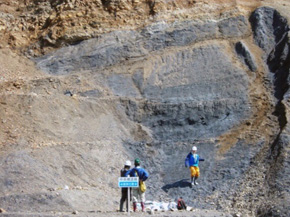


Crustal dynamics is largely controlled by the strength of fault that is a weak plane of the crust. Therefore, to predict the disturbance which may occur in the Japanese islands after a large earthquake, it is necessary to understand how fault zones have developed over a long period of time (tectonic history). In order to attain this objective, it is indispensable to observe the upper and lower crustal structures that include fault zone structures at the macroscopic level (several 10 km scales) to microscopic level (microscope scale). B01 group will analyze the paleo-stress field, development of fractures, and mass transfer and chemical reaction processes under the presence of fluids at: 1) the newly formed fault zone in western Tottori Prefecture, 2) the mature fault that was formed in the past and exposed at present due to uplifting and denudation (e.g. the Median Tectonic Line), and 3) brittle-ductile transition zone at the lower extension of brittle faults (e.g. the Hidaka mylonite). Based on the series of analysis, we aim to clarify from long-term fault creep (low-stress fault slip) to high-speed coseismic slip, the physical and chemical processes/mechanism at high and low speeds in fault zone, and their spatiotemporal changes. Furthermore, we aim to understand the crustal deformation from shallow part to deep part (20 km in depth from the earth surface) based on the structure at the deep crust obtained by the seismological observation and analysis at high accuracy and resolution including the hypocentral determination of aftershocks and seismic tomography.